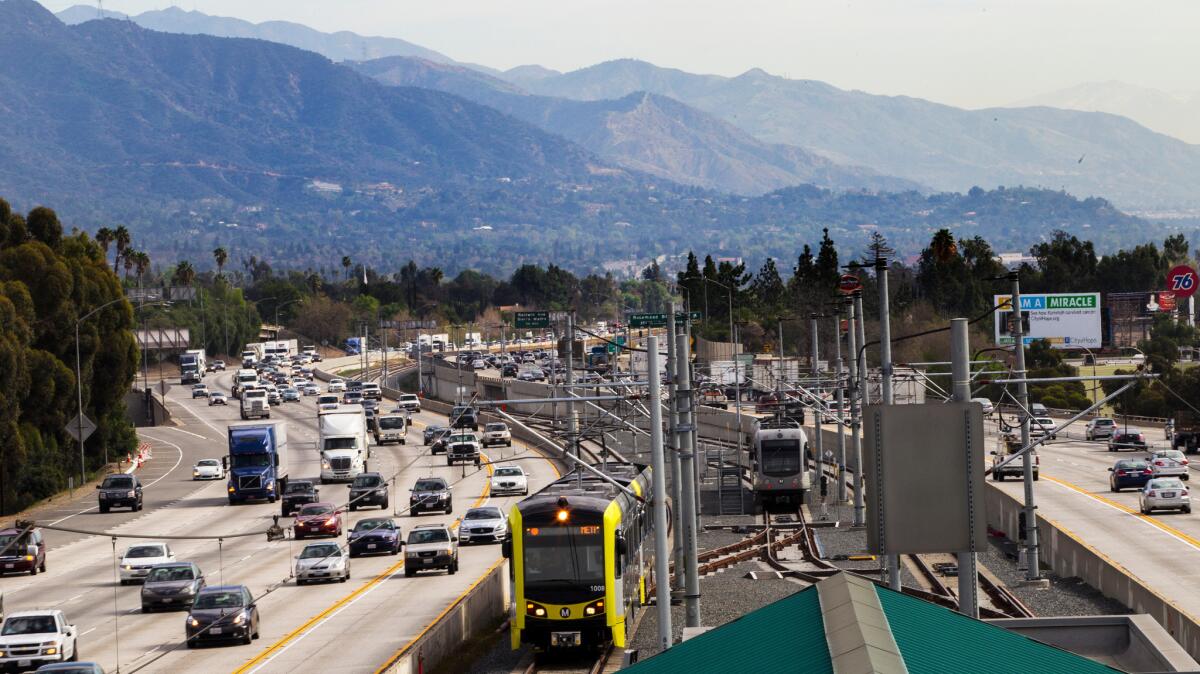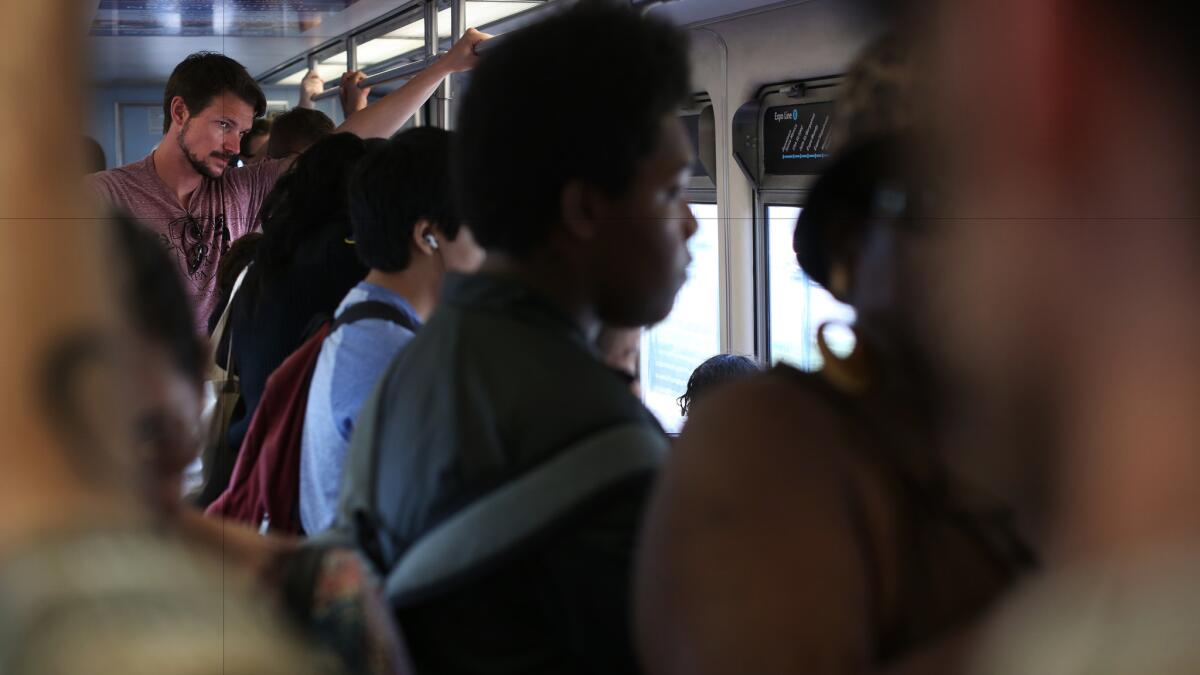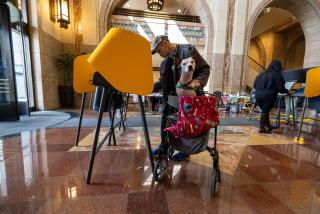Voters defeated Metro’s ambitious plan to raise money in 2012, and they might do it again
- Share via
Four years ago, a ballot measure to expand mass transit across Los Angeles County failed by less than 1 percentage point, a slim defeat attributed to voters in a chain of small, coastal cities outside the region’s core.
A similar dynamic has emerged this year in the southern part of the county, where leaders are opposing the Metropolitan Transportation Authority’s most ambitious plan yet to expand and upgrade transportation options across Southern California.
Metro’s ballot proposal, known as Measure M, would raise an estimated $860 million per year to fund transit operations, untangle highway bottlenecks and build nearly a dozen rail lines and extensions, including a rail tunnel through the Sepulveda Pass and connections to Pacoima, Norwalk, Claremont and Torrance.
Officials expect strong voter support for Measure M in central Los Angeles and on the Westside. But, experts say, discontent in the South Bay and the southeast portion of the county could thwart the measure from attaining the two-thirds majority needed for victory.
“These taxes pass or fail on the razor’s edge,” said Ethan Elkind, a UC Berkeley professor who wrote a book about the Metro system. “This has been a perpetual challenge for L.A., to make collective decisions in a county that’s so huge.”
These taxes pass or fail on the razor’s edge.
— UC Berkeley professor Ethan Elkind
Measure M would create a new half-cent sales tax with no end date. The rate would increase to 1% in 2039 when another half-cent tax expires.
A new, permanent source of revenue significantly increases Metro’s borrowing capacity, giving officials more leeway to draft one of the most ambitious transit expansion plans in recent U.S. history.
That plan has garnered support from Los Angeles Mayor Eric Garcetti and dozens of business, labor and government groups.
But in the southern half of the county, where about one-third of likely voters live, some officials have refused to endorse the measure, questioning whether their constituents would see their fair share of projects.
Leaders in Torrance, Signal Hill and Carson have slammed Metro for not allocating more funds for local transportation needs, including street repairs. Others have groused that the $891-million Green Line extension from Redondo Beach to Torrance, a project discussed for years, is not slated to break ground for a decade.
The South Bay Cities Council of Governments, which opposes Measure M, has criticized Metro for budgeting $6.6 billion in potential tax revenue to a rail tunnel through the Sepulveda Pass.
If history is any guide whatsoever, the costs will go up and up.
— Jacki Bacharach, executive director of the South Bay Council of Governments
When completed, the tunnel would connect the San Fernando Valley to the Westside and eventually to Los Angeles International Airport, which could transform commutes for Angelenos who battle congestion on the 405 Freeway.
“How do they know what it’s going to cost?” said the group’s executive director, Jacki Bacharach, noting that the project has not undergone a thorough environmental review. “If history is any guide whatsoever, the costs will go up and up.”
South Bay residents will see investments in local roads, freeways and transit systems before the Green Line begins service, said Yusef Robb, a spokesman for the Yes on Measure M campaign. And, he added, improvements to the transit system in one area help residents across the region.
“This measure isn’t just about the bus line or rail station that’s next to your house — it’s where it can go,” Robb said. “Voters need to understand that we need to vote now.”
This measure isn’t just about the bus line or rail station that’s next to your house — it’s where it can go.
— Yusef Robb, spokesman for the Yes on Measure M campaign
In a swath of cities between downtown Los Angeles and Long Beach, officials have complained that a long-planned transit link between Union Station and Artesia could be delayed by projects in the city of Los Angeles.
The so-called West Santa Ana Branch line would run about 19 miles through a series of working-class cities, including Bellflower and Huntington Park.
The line received seed funding and a tentative opening date of 2027 under Measure R, the half-cent tax approved in 2008. Under Measure M, the first half of the line would open in 2028, with the full ribbon-cutting in 2041.
About 10 cities in the South Bay and southeast area have donated funds to an “educational campaign” to inform residents about Measure M, said Al Austin, president of the Gateway Cities Council of Governments, which opposes the measure.
Robb, the Yes on Measure M spokesman, said that despite what leaders there say, voters in those southern and southeastern cities are supporting Measure M “in some of the highest levels we’ve seen,” based on campaign poll data that he declined to release.
A poll funded by Metro in May surveyed likely voters in all regions of the county, but the margin of error — 5.7 percentage points — was too high to be conclusive.

As he filled his Toyota truck at a gas station in Redondo Beach, Daniel Vives, 38, said he planned to vote for Measure M. Aside from the occasional trip to Lakers and USC games, he doesn’t use public transit because his work as a contractor makes his commutes unpredictable.
“But I like that the option is there,” Vives said. Investing in mass transit is important because it gives people choices, he said, and he holds out hope that it would make freeways less congested.
Since the last time Metro went to the ballot, officials have opened 18 miles of rail and 12 new stations in the San Gabriel Valley and on the Westside.
The Expo Line’s ridership has soared by half since a year ago, aided by the new $1.5-billion extension to Santa Monica. Metro surveys indicate that 70% of the extension’s riders are new to the line. The Gold Line, which opened an extension to Azusa in March, has seen a 20% increase in total ridership.
“In many ways, these measures are a referendum on the job that Metro is doing,” Elkind said. That could cut either way, he said: commuters pleased with new rail options, or riders frustrated by service problems.
Metro has also grappled with crowded cars and late trains on the Expo Line and recurring breakdowns across the system. Bus ridership, which represents about three-fourths of Metro’s total ridership, continues to fall, declining 6.6% from August 2015 to this year.
Measure M would allocate 27% of total revenue toward transit operations and maintenance, which advocates say could solve those issues.

Ana Rojas, 40, stood on the sidewalk outside Union Station on a recent weekday and squinted into the sun, waiting for the Line 70 bus to rumble along Cesar Chavez Avenue. Every day, she rides two buses between her Pico Rivera apartment and her job cleaning offices in downtown.
One Measure M project, an extension of the Gold Line from East Los Angeles to Whittier, could shift her commute from two buses to one train. But the extension will not open for at least two decades.
“That’s a long time to wait,” Rojas said. If the measure passes, she said, she hopes her bus starts coming more often.
For more transportation news, follow @laura_nelson on Twitter.
ALSO
Pasadena and other California cities weigh a ‘Netflix tax’ for video subscribers
17 arrested following protests after fatal El Cajon police shooting
A dozen homes destroyed as Loma fire scorches Santa Cruz Mountains
More to Read
Sign up for Essential California
The most important California stories and recommendations in your inbox every morning.
You may occasionally receive promotional content from the Los Angeles Times.











